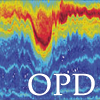|
Anda Vladoiu Senior Oceanographer avladoiu@apl.uw.edu Phone 206-685-9080 |
Department Affiliation
 |
Ocean Physics |
Education
M.S. Oceanography, University of Southampton (Southampton, UK), 2015
Ph.D. Physical Oceanography, University of Sorbonne (Paris, France), 2018
|
Publications |
2000-present and while at APL-UW |
Finescale measurements of Kelvin-Helmholtz instabilities at a Kuroshio seamount Vladoiu, A., R.-C. Lien, E. Kunze, B. Ma, S. Essink, Y.J. Yang, M.H. Chang, S. Jen, J.L. Chen, K.C. Yang, Y.Y. Yeh, "Finescale measurements of Kelvin-Helmholtz instabilities at a Kuroshio seamount," J. Phys. Oceanogr., 55, 2097-2117, doi:10.1175/JPO-D-24-0235.1, 2025. |
More Info |
1 Nov 2025 |
|||||||
|
Finescale properties of Kelvin-Helmholtz (KH)-like shear instabilities on the trailing edge of a nonlinear lee wave generated by the Kuroshio impinging on a seamount were measured using a towed CTD chain, shipboard ADCP, and echosounder. Lee-wave vertical velocity amplitudes vary in phase with the upstream semidiurnal along-stream current. The instabilities are analogous to atmospheric billows induced by a recirculation on the trailing edge of mountain lee waves. A total of 135 KH billows were identified in a 4-day-long time series roughly 300 m downstream of the center of the lee wave. The KH billows have heights H = 52 ±11 m, widths L = 162 ± 72 m, and aspect ratios H/L = 0.39 ± 0.18. Positive reduced shear squared S2 – 4N2 (where S is the vertical shear magnitude and N is the buoyancy frequency) in the shear-stratified billows suggests actively growing instabilities, with comparable contributions from across- and along-flow vertical shear. Billow cores are convectively unstable (N2 < 0). Large turbulent kinetic energy dissipation rates similar to O(10-5)Wkg-1 are inferred from density overturns. Density, shear, and inferred turbulence properties vary with billow aspect ratios. As H/L increases, density gradients smear out. For 122 billows with H/L < 0.6, dissipation rates increase by one order of magnitude with increasing H/L. These observations of similar to 1-m vertical and similar to 5-m horizontal resolution billow structures and density overturn dissipation rates can provide a reference for future high-Reynolds-number direct numerical simulations. |
|||||||||
A divergence and vorticity view of nonlinear oceanic lee wave obtained by a two-vessel survey Chuang, T.-L., J.-L. Chen, M.-H. Chang, R.-C. Lien, Y.-H. Cheng, Y.J. Yang, S. Jan, and A. Vladoiu, "A divergence and vorticity view of nonlinear oceanic lee wave obtained by a two-vessel survey," J. Geophys. Res., 130, doi:10.1029/2024JC021422, 2025. |
More Info |
1 Mar 2025 |
|||||||
|
Key Points |
|||||||||
Turbulence generation via nonlinear lee wave trailing edge instabilities in Kuroshio–seamount interactions Yeh, Y.Y., and 7 others including R.-C. Lien and A. Vladoiu, "Turbulence generation via nonlinear lee wave trailing edge instabilities in Kuroshio–seamount interactions," J. Geophys. Res., 129, doi:10.1029/2024JC020971, 2024. |
More Info |
1 Sep 2024 |
|||||||
|
Physical processes behind flow-topography interactions and turbulent transitions are essential for parameterization in numerical models. We examine how the Kuroshio cascades energy into turbulence upon passing over a seamount, employing a combination of shipboard measurements, tow-yo microstructure profiling, and high-resolution mooring. The seamount, spanning 5 km horizontally with two summits, interacts with the Kuroshio, whose flow speed ranges from 1 to 2 m s-1, modulated by tides. The forward energy cascade process is commenced by forming a train of 2–3 nonlinear lee waves behind the summit with a wavelength of 0.5–1 km and an amplitude of 50–100 m. A train of Kelvin–Helmholtz (KH) billows develops immediately below the lee waves and extends downstream, leading to enhanced turbulence. The turbulent kinetic energy dissipation rate is O (10-7–10-4) W kg-1, varying in phase with the upstream flow speed modulated by tides. KH billows occur primarily at the lee wave's trailing edge, where the combined strong downstream shear and low-stratification recirculation trigger the shear instability, Ri < 1/4. The recirculation also creates an overturn susceptible to gravitational instability. This scenario resembles the rotor, commonly found in atmospheric mountain waves but rarely observed in the ocean. A linear stability analysis further suggests that critical levels, where the KH instability extracts energy from the mean flow, are located predominantly at the strong shear layer of the lee wave's upwelling portion, coinciding with the upper boundary of the rotor. These novel observations may provide insights into flow-topography interactions and improve physics-based turbulence parameterization. |
|||||||||




